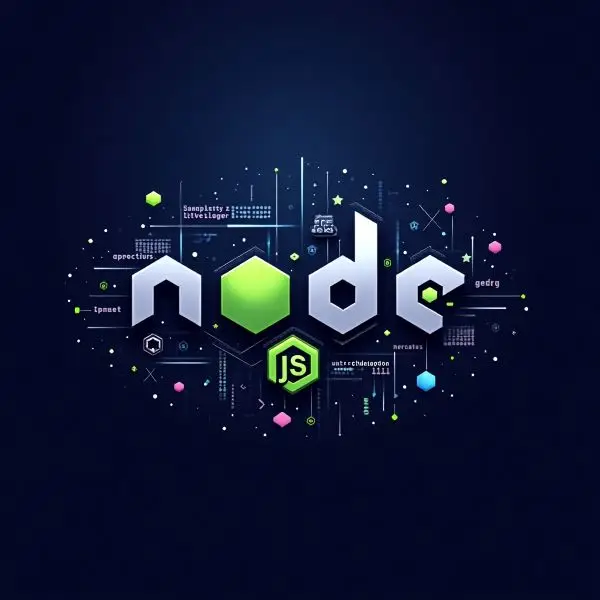
Introduction to OpenAI API and How to Use It in Node.js
In the rapidly evolving world of technology, artificial intelligence (AI) is making remarkable strides in changing how we interact with digital systems. OpenAI, a leading figure in the AI frontier, has been at the helm of innovation, bringing transformative advancements with tools designed to revolutionize industries across the globe. One such powerful tool is the OpenAI API, a versatile API that allows developers to create intelligent, human-like applications across a variety of domains. As developers, harnessing the capabilities of APIs like those from OpenAI can significantly enhance our applications, providing cutting-edge features without the need for deep expertise in AI. Whether it's drafting an article, engaging in natural conversation, or translating languages seamlessly, the potential applications are nearly boundless.
Node.js, renowned for its efficiency and scalability in building high-performance applications, serves as the perfect companion for integrating the OpenAI API into your tech stack. In this article, we will embark on a journey to explore the world of OpenAI API, guiding you through the setup, integration, and implementation in a Node.js environment. By the end, you’ll be equipped to start crafting intelligent applications that showcase the power and versatility of AI. Let's dive in and unlock new possibilities together!
List of Contents
Understanding the OpenAI API
In this section, we'll delve into the core aspects of the OpenAI API, unraveling its capabilities and setting the stage for practical integration into applications. The OpenAI API serves as a bridge between cutting-edge artificial intelligence and your software, enabling a new array of functionalities that were once the realm of science fiction. Let's explore what the OpenAI API is and how you can harness its power in your projects.
What is the OpenAI API?
The OpenAI API is a set of powerful external interfaces that allow developers to access and utilize OpenAI's state-of-the-art language models, such as GPT-3 or GPT-4, for various applications. By providing a simple and flexible interface, OpenAI enables applications to perform tasks that involve understanding and generating human language with remarkable accuracy and fluency. These tasks include text completion, conversational agents, content generation, and more. The API democratizes access to sophisticated AI models, meaning you don't need extensive expertise in machine learning to leverage its capabilities. By utilizing this API, developers can focus on innovative applications while relying on OpenAI's foundational models for the heavy lifting of AI computations.
Key Concepts and Terminology
To effectively use the OpenAI API, it's crucial to familiarize yourself with some essential concepts and terminology. Understanding these will ensure you make the most of the API's features and navigate its documentation and capabilities smoothly.
- GPT Models: The heart of the OpenAI API is the Generative Pre-trained Transformer (GPT) models, with GPT-4 being the most prominent. These models are trained on vast amounts of text data and can generate human-like text based on prompts provided by the developer.
- Endpoints: OpenAI API's functionality is accessed via specific endpoints, each designed for different types of tasks or queries. Understanding which endpoint to use for your specific need is crucial for developing effective applications.
- API Key: Access to the OpenAI API requires a unique API key, which serves as your credentials. It is important to handle your API key securely, as it controls access to your billing account and usage.
- Rate Limits and Pricing: The OpenAI API operates under usage limits and tiered pricing models based on the complexity of tasks and frequency of requests. Familiarizing yourself with these will help optimize usage and manage costs efficiently.
By understanding these foundational aspects of the OpenAI API, you're better prepared to dive into practical implementations, ensuring you use it effectively within the Node.js environment. This sets the groundwork for the succeeding sections, where we will explore setting up your environment and making requests to the API.
Accessing the OpenAI API
With a fundamental understanding of what the OpenAI API is and its key concepts, it's time to roll up your sleeves and start accessing this powerful tool. This section will guide you through obtaining access to the API, setting up your development environment, and starting your first interaction with the API using Node.js.
Obtaining API Access
Before you can utilize the OpenAI API, you need to set up an account with OpenAI and obtain an API key. This key is your passport to accessing the various endpoints and functionalities provided by the API. Here's how you can get started:
- Sign Up for OpenAI API Access
- Head over to the OpenAI website and create an account. If you're an individual developer or a business, OpenAI provides different plans suited to your needs.
- Once registered, you may need to apply for specific API access if it's in a closed beta or requires approval.
- Retrieve Your API Key
- After signing up, navigate to your account settings or API section to generate and retrieve your API key. This key is unique to your account and provides access to the API endpoints.
- Secure Your API Key
- Treat your API key like a password. Store it securely and avoid exposing it in public repositories or client-side code. Using environment variables is a common and secure practice.
Setting Up Your Node.js Application
With your API key in hand, it's time to set up your Node.js environment to make requests to the OpenAI API. This involves creating a new Node.js project and preparing your environment for development.
1. Create a New Node.js ProjectOpen your terminal and create a new directory for your project. Navigate into this directory and initialize a new Node.js project by running:
mkdir openai-nodejs-project
cd openai-nodejs-project
npm init -y
The npm init -y command generates a package.json file with the default settings, serving as the project's configuration file.
For making HTTP requests to the OpenAI API, you can use popular packages like axios for promise-based requests and dotenv for environment variable management. Install them by running:
Create a .env file in your project root to store your API key:
OPENAI_API_KEY=your-api-key-hereNow that your setup is complete, you're ready to write your first Node.js code to interact with the OpenAI API. This setup ensures you have a secure and organized environment, laying the foundation for making requests and handling responses efficiently. In the next sections, we will cover writing code to access the API and handling the data returned from API calls.
Building a Basic Application with OpenAI API
With your Node.js environment set up and your API key securely in place, it's time to bring your application to life by making requests to the OpenAI API. In this section, we'll walk through writing a simple Node.js application that interacts with the API, showcasing basic functionalities such as text completion.
Writing Node.js Code to Call OpenAI API
To start interacting with the OpenAI API, we'll write a script that sends a request for text completion. This will help you understand the mechanics of making API calls and processing results.
Set Up Configurations and Environment VariablesEnsure your project is set up to read environment variables from your .env file. In your main JavaScript file (e.g., index.js), add the following:
require('dotenv').config();
const axios = require('axios');
const apiKey = process.env.OPENAI_API_KEY;
const apiUrl = 'https://api.openai.com/v1/completions';To request text completion, you'll need to send a POST request to the relevant endpoint. Create a function to handle this request:
async function generateText(prompt) {
try {
const response = await axios.post(apiUrl, {
model: 'text-davinci-003', // Use the relevant model name
prompt: prompt,
max_tokens: 150 // Control response length
}, {
headers: {
'Authorization': `Bearer ${apiKey}`,
'Content-Type': 'application/json'
}
});
const completion = response.data.choices[0].text.trim();
console.log('Generated Text:', completion);
} catch (error) {
console.error('Error calling OpenAI API:', error);
}
}Now that you have the function set up to make API requests, invoke it with a prompt to see the magic
const prompt = "Once upon a time in a land far, far away";
generateText(prompt);Handling API Responses
When interacting with the OpenAI API, understanding how to handle responses and errors will enrich the robustness of your application.
- Parsing JSON Responses
- The API returns responses in JSON format. In our
generateTextfunction, notice how the response is accessed usingresponse.data.choices[0].text. This is where the text completion resides.
- The API returns responses in JSON format. In our
- Error Handling and Debugging
- Always wrap your API calls in try-catch blocks to gracefully handle errors. This ensures that your application can provide informative error messages and proceed with fallback logic if necessary.
- Log the full error object to gain insights into request issues during debugging.
By following these steps, you've built a simple application that calls the OpenAI API to generate text content. This experience lays the groundwork for expanding your application, whether through adding features like adjustable parameters or integrating more complex conversational flows.
Common Use Cases and Examples
The OpenAI API's ability to understand and generate human-like text makes it a versatile tool for a wide range of applications. In this section, we'll explore some popular use cases and provide example implementations to illustrate how you can leverage the API in your own projects.
Text Completion
One of the primary functionalities of the OpenAI API is text completion, which can be used to automate content generation, offer writing assistance, and more. Here's how you can implement this feature: Auto-generating Article Content
Imagine you're building a blogging tool that assists writers by generating paragraph suggestions based on a provided topic.
async function generateArticleContent(topic) {
const prompt = `Write a comprehensive paragraph about ${topic}.`;
await generateText(prompt);
}
// Run the example
generateArticleContent("the benefits of artificial intelligence in education");This function sends a prompt to the API and outputs a relevant paragraph, streamlining the content creation process.
Conversation and Chatbots
The ability to engage in dynamic conversation is a powerful feature of the OpenAI API, enabling the creation of intelligent chatbots and virtual assistants: Building a Basic Chatbot
Let's create a simple chatbot that responds to user input dynamically.
async function chatWithBot(userInput) {
const prompt = `You are a friendly chatbot. User says: "${userInput}".`;
await generateText(prompt);
}
// Simulate user interaction
chatWithBot("Hello, how can you help me today?");This example demonstrates how to initiate dialogue, providing a foundation for building more complex conversational agents that can be tailored to specific tasks.
Language Translation
Another exciting application is language translation, where the API can assist in converting text between languages: Real-time Text Translation
Though the OpenAI API isn't specifically designed to be a translation tool, it can creatively generate translations by rephrasing prompts:
async function translateText(text, targetLanguage) {
const prompt = `Translate the following text to ${targetLanguage}: "${text}".`;
await generateText(prompt);
}
// Translate text to French
translateText("Hello, how are you?", "French");By instructing the API to translate text into a target language, you can create innovative translation applications that harness the API's linguistic capabilities. Each of these examples provides a glimpse into the diverse applications possible with the OpenAI API. By understanding these use cases, you can envision implementing them in your projects while thinking strategically about new ways to innovate and expand functionality.
Advanced Features and Considerations
As you become more familiar with the OpenAI API and its basic functionalities, you may want to explore its advanced features and understand important considerations to maximize its effectiveness while adhering to best practices. This section highlights some of these advanced capabilities and crucial points.
Fine-Tuning GPT Models
While the OpenAI API provides access to powerful pre-trained models, certain applications might require a level of customization for specific tasks or domains. Fine-tuning allows you to train these models further on your specific dataset, enhancing their performance in tailored applications.
- Overview of Customized Model Training
- Fine-tuning involves retraining a model on additional data, allowing you to refine its outputs to better suit specific needs like industry-specific jargon or unique response styles.
- Practical Applications of Fine-Tuning
- Whether you’re developing a specialized customer service bot, content generator with a specific tone, or any application where domain specificity is integral, fine-tuning can elevate your application’s performance significantly.
- Considerations for Fine-Tuning
- Be mindful of data quality; better data yields more effective models.
- Understand the costs associated with fine-tuning both in terms of computational resources and API usage.
Best Practices for Using OpenAI API
To ensure optimal performance and ethical use of the OpenAI API, consider the following best practices:
- Efficient API Usage Strategies
- Optimize requests for reduced latency and cost-effectiveness by carefully selecting model parameters such as
max_tokensand usingtemperaturesettings to adjust creativity. - Cache frequent responses to minimize unnecessary requests and reduce operational costs.
- Optimize requests for reduced latency and cost-effectiveness by carefully selecting model parameters such as
- Data Privacy and Ethical Considerations
- Understand OpenAI's data usage policies and adhere to them to protect user data and privacy.
- Foster transparency in your application's AI capabilities—inform users when they are interacting with AI-generated content.
- Be mindful of the potential for bias in AI models and actively mitigate its impact by choosing diverse and representative data.
- Continuous Learning and Adaptation
- Stay informed about new features, updates, and ethical guidelines provided by OpenAI to continuously adapt your application.
- Engage with community forums and OpenAI's resources to learn from fellow developers and contribute to discussions on responsible AI development.
By leveraging fine-tuning, adhering to best practices, and considering the ethical implications, you can effectively use the OpenAI API to build sophisticated applications that are both powerful and responsible. This approach not only enhances application performance but also ensures alignment with industry standards and ethical expectations.
Summary
As we come to the end of our exploration into the OpenAI API and its integration with Node.js, it's clear that the landscape of application development is rapidly evolving, propelled by the capabilities of artificial intelligence. Through this journey, we've demystified the OpenAI API and demonstrated how it can be employed to empower applications with intelligent, human-like interactions.
We've started from understanding the API's foundational concepts, through setting up a Node.js environment, and finally implementing basic yet powerful functionalities like text completion and chatbots. Additionally, we examined common use cases and delved into advanced features that allow customization through fine-tuning, ensuring that your applications can be tailored to specific needs while adhering to best practices.
By integrating OpenAI's services into your applications, you're not just adopting a tool; you're unlocking a realm of possibilities where creativity meets technology.
Thank you for embarking on this journey into AI-powered development. I hope you've found this guide insightful and empowering, and that it inspires you to continue exploring and innovating with the tools available at your fingertips. The future of AI in application development awaits your creativity!



